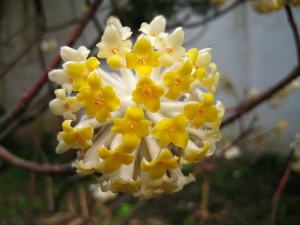 In early spring every sprout that pushes up from the ground is a cause for celebration—unless, of course, the sprout is onion grass. While I struggle to accept the things I cannot change—onion grass is one of them—I celebrate the plants that emerge bravely and mark the season with beauty and fragrance. One of the loveliest of these is paperbush, known botanically as Edgeworthia chrysantha or sometimes Edgworthia papyrifera.
In early spring every sprout that pushes up from the ground is a cause for celebration—unless, of course, the sprout is onion grass. While I struggle to accept the things I cannot change—onion grass is one of them—I celebrate the plants that emerge bravely and mark the season with beauty and fragrance. One of the loveliest of these is paperbush, known botanically as Edgeworthia chrysantha or sometimes Edgworthia papyrifera.
I have wanted one for years, but I would have to remove something else to accommodate it. At the moment I am eyeballing the roses of Sharon and thinking about whether I really need all six of them. Maybe the paperbush cause is not lost.
To bolster my resolve, I direct my steps, or at least my car, to a nearby “vest pocket” botanical garden that is home to a paperbush, now in bloom and broadcasting its spicy fragrance to anyone within range.
At maturity, paperbush grows six to seven feet tall, producing an array of flexible stems from just above ground level, creating a dome effect during the growing season. In this part of the world, the blue-green, oblong leaves are deciduous and grow opposite each other on the stems. When young, they are covered with very fine hairs. The flowers, which are the species’ greatest glory, grow on “old wood”, with buds forming in late summer and overwintering on the stems. The buds swell into an elegant silver buttons and finally produce flowers in the late winter or early spring. The tiny tubular blooms, which can be cream, yellow or even orange-red, cluster into domed flowerheads or umbels that droop from the stems like little hanging baskets.
The flowers are showy enough to stop traffic by themselves, but the fragrance is singular and pervasive. In gardens the shrubs should really be positioned close to high traffic areas for maximum appreciation.
The first Edgeworthias came from China, where they grow as woodland edge plants. In 1845, plant hunters brought them back to England, where the shrubs attracted attention because of their beauty and early-flowering nature. Here in the United States, the only downside to edgeworthia is that its growing range is limited to USDA plant hardiness zones 7 through 9. If you live in Zone 6b and plant a paperbush near a building or in a protected spot, it might thrive.
So why is edgeworthia known as “paperbush”? Apparently the Japanese have long made fine paper from the underbark of Edgeworthia chrysantha or, possibly, a closely related species. As is often the case, plant taxonomists disagree.
But there is another paper association of a different type. The genus name honors Michael Pakenham Edgeworth, a mid-nineteenth century Anglo-Irish amateur botanist and plant collector. His half sister, Maria Edgeworth, was a major novelist of the time and went through a lot of paper, producing literature for adults and children. She was also known as a feminist, diarist and correspondent, with a large network of influential friends. Clearly a papery thread connects the family to the plants.
For some reason, probably the limited range, paperbush is less popular than other early bloomers, like various daphnes. Still, the shrubs are available commercially if you know where to look. ‘Akebono’, sometimes called ‘Red Dragon’, is an attention grabber, with reddish-orange flowers. The slightly larger—up to eight feet tall–‘Nanjing Gold’, features cream to golden yellow umbels. ‘Snow Cream’ boasts extra-large creamy yellow flowers with the same rich fragrance.
To give your paperbush the best chance of success, plant it in rich soil in light shade. Mulch thoroughly and water during dry periods, as the plants tend to resent hot, dry summer weather. If you are planning on pruning as the plant gets bigger, do so right after it blooms, so you do not interfere with the next year’s flower production.
Excellent local nurseries may carry edgeworthia, so it pays to make a few calls. Curiously, two highly regarded mail order suppliers, Digging Dog Nursery and Plant Delights Nursery, currently list their edgeworthia offerings as “sold out”. Both offer plant lovers the opportunity of receiving notifications when plants are restocked. You can also order the shrubs from Wilson Brothers Gardens, 1759 McGarity Road, McDonough, GA. 30252; (770) 573-1778; www.wilsonbrothersgardens.com.
